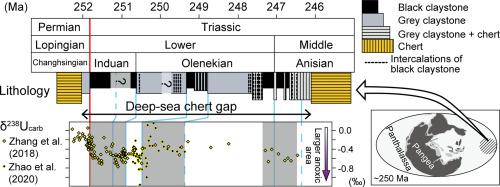当前位置:
X-MOL 学术
›
Glob. Planet. Change
›
论文详情
Our official English website, www.x-mol.net, welcomes your feedback! (Note: you will need to create a separate account there.)
Recurrent deposition of organic-rich sediments in Early Triassic pelagic Panthalassa and its relationship with global oceanic anoxia: New data from Kyoto, Southwest Japan
Global and Planetary Change ( IF 3.9 ) Pub Date : 2021-02-01 , DOI: 10.1016/j.gloplacha.2020.103402 Shun Muto
Global and Planetary Change ( IF 3.9 ) Pub Date : 2021-02-01 , DOI: 10.1016/j.gloplacha.2020.103402 Shun Muto

|
Abstract The Early Triassic experienced one of the most extensive episodes of oceanic oxygen depletion in the Phanerozoic, which was considered to be reflected in the deposition of black organic-rich claystone and general absence of radiolarian chert in pelagic deep-water areas of Panthalassa. However, while studies of peri-continental sections demonstrate that oceanic anoxia repeatedly occurred throughout the Early Triassic, black claystone deposition was thought to be restricted to earliest Triassic times. In this paper, the lithostratigraphy, conodont biostratigraphy and chemical composition are investigated at two Olenekian–Anisian sections in Japan, deposited in pelagic deep-water areas of Panthalassa. Sedimentation rates and major element compositions support published findings that the absence of chert is a consequence of increased clastic input and not radiolarian extinction due to oceanic anoxia. Biostratigraphic correlation with previously described sections reveals that the deposition of extensive black claystone occurred in the Induan, early Spathian (early late Olenekian) and across the Olenekian–Anisian boundary. Three black claystone lithofacies are associated with sedimentary and geochemical evidence of anoxia in the water column and bottom waters. Organic-rich deposition is generally coeval with episodes of expanded anoxic seafloor as indicated by uranium isotopes, although they are decoupled in Smithian (early Olenekian) times. Black claystone of end-Olenekian to early Anisian age represents the first finding of a laterally extensive deposit associated with oceanic anoxia during this time interval. Results imply that the deposition of black organic-rich claystone in pelagic deep Panthalassa reflects global trends in the spatial extent of bottom water anoxia during the Early Triassic, probably controlled mainly by nutrient input to the oceans.
中文翻译:

早三叠世远洋泛海区富含有机质沉积物的反复沉积及其与全球海洋缺氧的关系:来自日本西南部京都的新数据
摘要 早三叠世经历了显生宙最广泛的海洋氧耗竭事件之一,这被认为反映在泛海区远洋深水区黑色富含有机质粘土岩的沉积和放射虫燧石的普遍缺失上。然而,虽然对陆缘部分的研究表明,在整个早三叠世期间,海洋缺氧反复发生,但黑色粘土岩沉积被认为仅限于最早的三叠纪时期。在本文中,研究了沉积在 Panthalassa 远洋深水区的日本 Olenekian-Anisian 两个剖面的岩石地层学、牙形石生物地层学和化学成分。沉积率和主要元素组成支持已发表的研究结果,即没有燧石是碎屑输入增加的结果,而不是由于海洋缺氧导致的放射虫灭绝。与先前描述的剖面的生物地层相关性表明,大量黑色粘土岩的沉积发生在 Induan、Spathian 早期(Olenekian 晚期早期)和 Olenekian-Anisian 边界。三种黑色粘土岩相与水柱和底水中缺氧的沉积和地球化学证据有关。富含有机物的沉积通常与铀同位素表明的膨胀缺氧海底事件同时发生,尽管它们在史密斯时代(奥列尼克时代早期)是分离的。Olenekian 末期至 Anisian 早期的黑色粘土岩代表了在此时间间隔内首次发现与海洋缺氧相关的横向广泛沉积物。结果表明,在远洋深部 Panthalassa 中黑色富含有机质粘土的沉积反映了早三叠世底水缺氧空间范围的全球趋势,可能主要受海洋养分输入控制。
更新日期:2021-02-01
中文翻译:

早三叠世远洋泛海区富含有机质沉积物的反复沉积及其与全球海洋缺氧的关系:来自日本西南部京都的新数据
摘要 早三叠世经历了显生宙最广泛的海洋氧耗竭事件之一,这被认为反映在泛海区远洋深水区黑色富含有机质粘土岩的沉积和放射虫燧石的普遍缺失上。然而,虽然对陆缘部分的研究表明,在整个早三叠世期间,海洋缺氧反复发生,但黑色粘土岩沉积被认为仅限于最早的三叠纪时期。在本文中,研究了沉积在 Panthalassa 远洋深水区的日本 Olenekian-Anisian 两个剖面的岩石地层学、牙形石生物地层学和化学成分。沉积率和主要元素组成支持已发表的研究结果,即没有燧石是碎屑输入增加的结果,而不是由于海洋缺氧导致的放射虫灭绝。与先前描述的剖面的生物地层相关性表明,大量黑色粘土岩的沉积发生在 Induan、Spathian 早期(Olenekian 晚期早期)和 Olenekian-Anisian 边界。三种黑色粘土岩相与水柱和底水中缺氧的沉积和地球化学证据有关。富含有机物的沉积通常与铀同位素表明的膨胀缺氧海底事件同时发生,尽管它们在史密斯时代(奥列尼克时代早期)是分离的。Olenekian 末期至 Anisian 早期的黑色粘土岩代表了在此时间间隔内首次发现与海洋缺氧相关的横向广泛沉积物。结果表明,在远洋深部 Panthalassa 中黑色富含有机质粘土的沉积反映了早三叠世底水缺氧空间范围的全球趋势,可能主要受海洋养分输入控制。


























 京公网安备 11010802027423号
京公网安备 11010802027423号